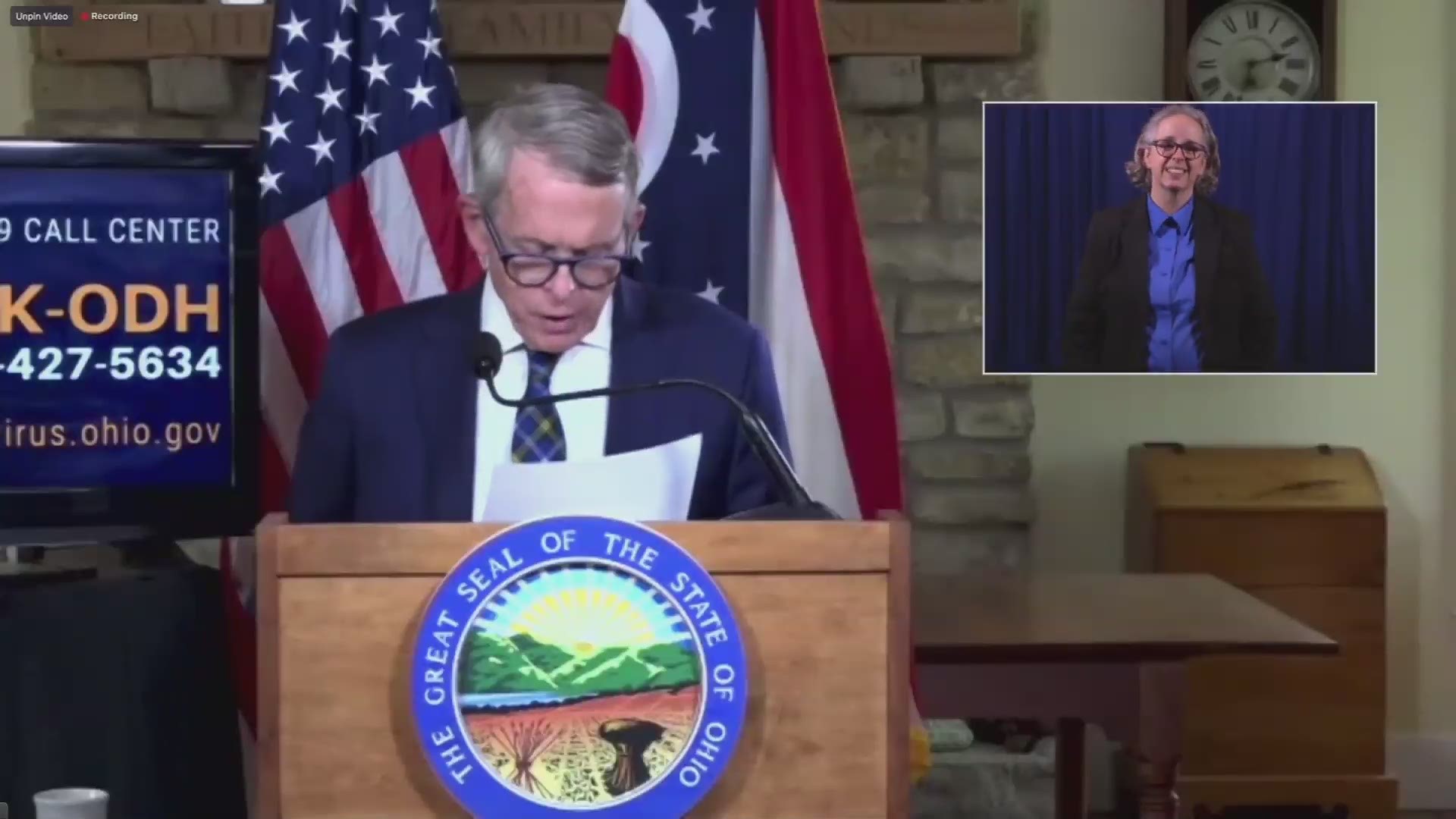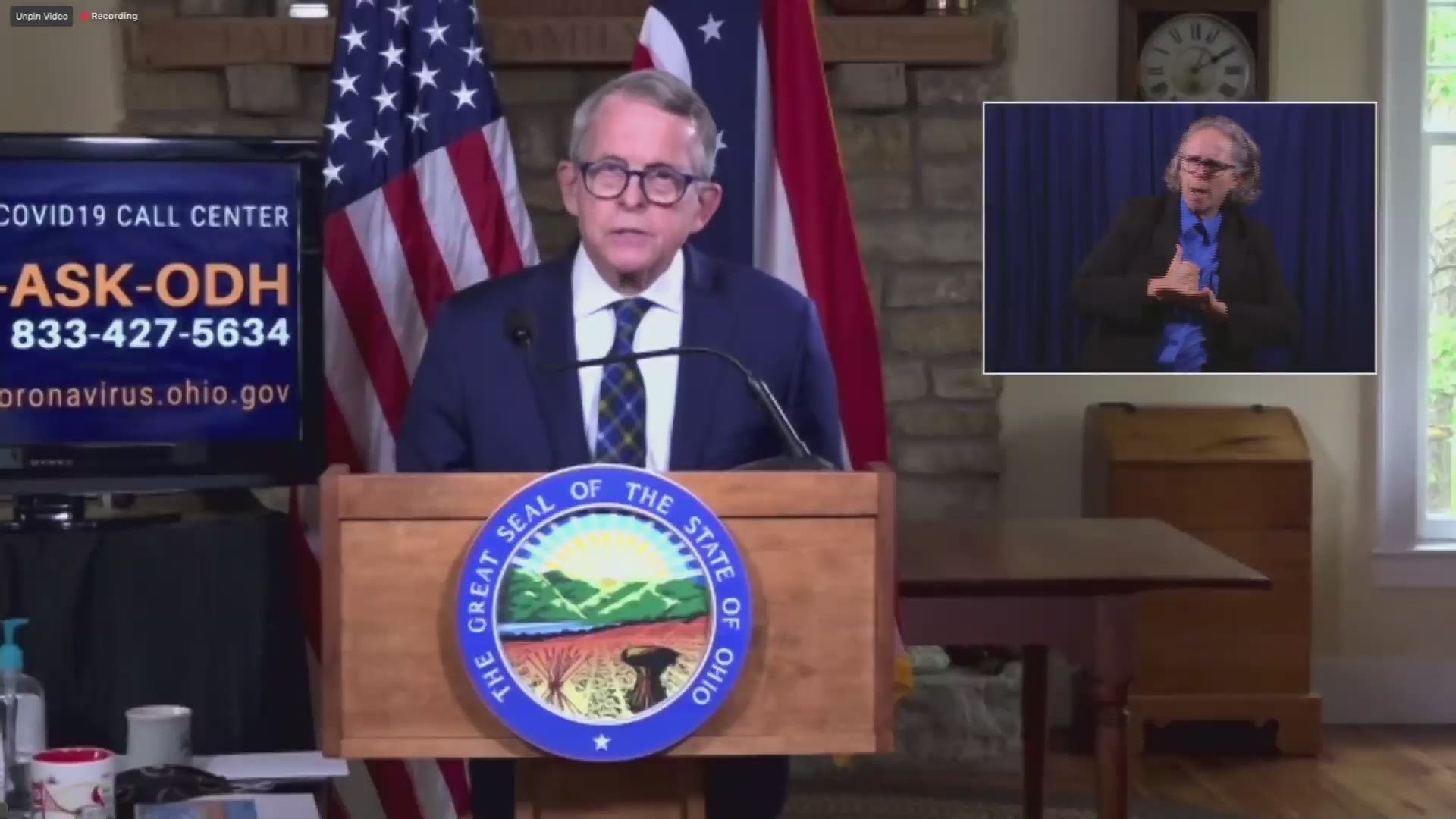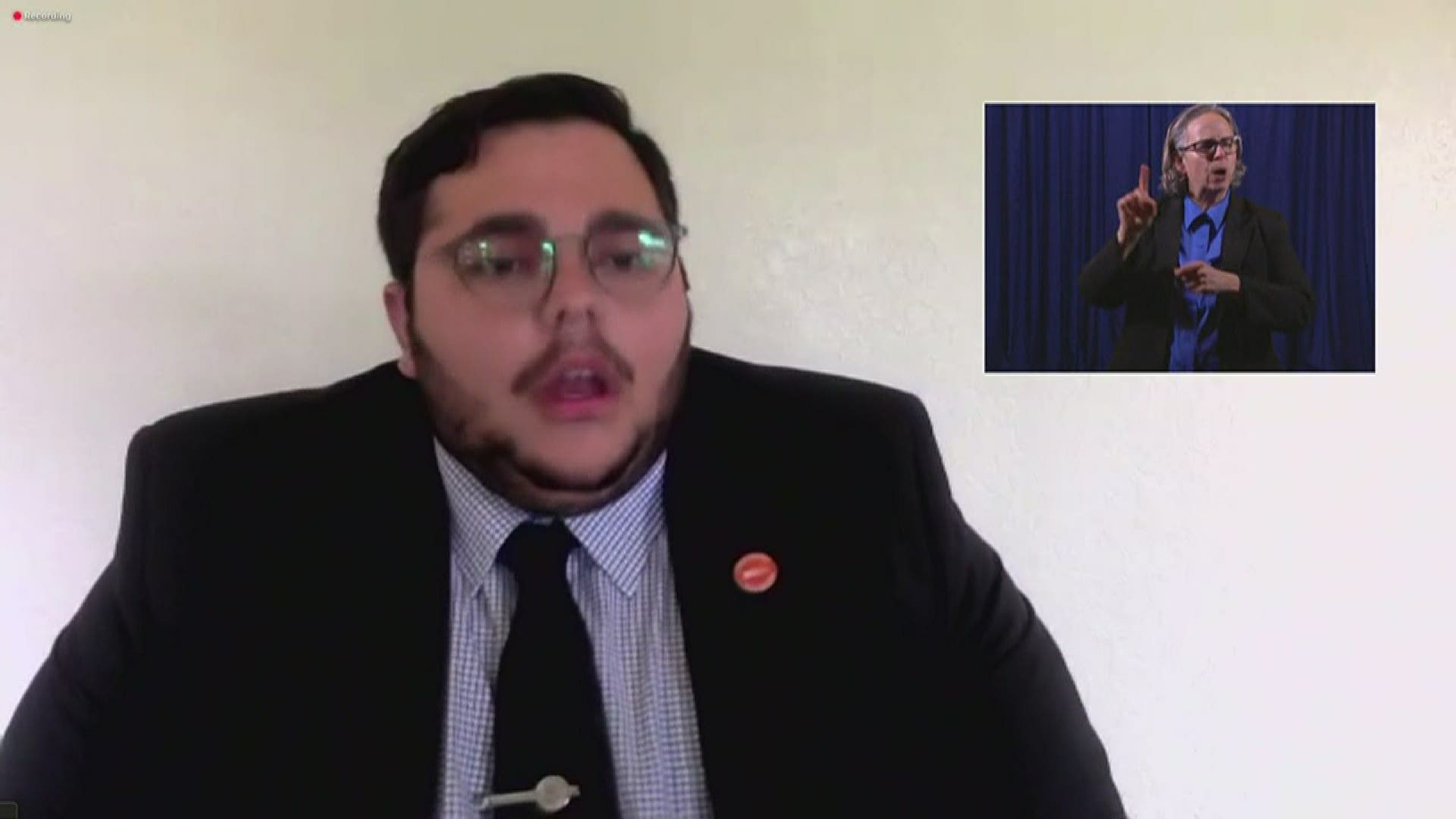COLUMBUS, Ohio — Ohio Gov. Mike DeWine is set for another coronavirus press conference Thursday at 2 p.m. with new information on the state's response to COVID-19.
Thursday marked six months since DeWine, alongside former Ohio Dept. of Health Director Dr. Amy Acton made the decision to cancel spectators for the Arnold Sports Festival, a move the governor said "was a tough decision but it set Ohio on a good path."
KEY INDICATORS
There were 1,345 new cases of coronavirus reported on Thursday compared to the 21-day average of 1,033.
There were 50 new coronavirus-related deaths, the highest number reported in a single day since June.
Hospitalizations and ICU admissions were up as well, with 89 and 14 reported respectively on Thursday. Those averages over the last 21 days come in at 78 and 12.
CASES PER 100,000
DeWine updated his list of counties with the most cases per 100,000 people.
On Thursday, Putnam topped the list with 268.7 cases per 100,000. This is well above the Centers for Disease Control and Prevention's threshold of 100 for high incidence.
Henry County was also in the top 10, taking the ninth spot. Henry was reported to have 178 cases per 100,000.
PUBLIC HEALTH ADVISORY MAP
There are now 39 yellow counties, the highest since July 2. In fact, the population of Ohioans in yellow counties hit an all-time high with 26% now living under Level 1 (Yellow).
Seven counties are in the Level 3 (Red) category, however, including Putnam and Lucas.
Putnam is in the red for the first time this week. The county has the highest rate of cases per 100,000, with a sustained increase in new cases. In the past two weeks, there were 91 new cases, with 398 total since the beginning of the pandemic. This means that a quarter of the county's cases have popped up in just two weeks. Putnam increased from an average of 3/6 cases per day to an average of 9.3 cases per day. The county has also noted an increase in ER visits from coronavirus-like illnesses.
Lucas still meets the CDC's threshold of high incidence with 112 cases per 100,000. In the last two weeks alone, there were 481 new cases reported, with several outbreaks in long-term care facilities.
WOOD COUNTY OUTBREAK
DeWine made note on Thursday about a number of small social gatherings that led to cases in Wood County. The governor explained that the people who were exposed have now spread the virus to others.
The county has at least 14 confirmed cases associated with a university move-in day on Aug. 27.
LABOR DAY WEEKEND
DeWine said that Vice President Mike Pence asked him directly to address the potential for spread over the upcoming Labor Day weekend.
"What we do, what we don't do, will certainly determine the fall," DeWine said.
The governor said he still encourages everyone to have fun, and reminds Ohioans that they are allowed to travel. However, he said that it isn't so much about where we go, but it's about how Ohioans act when with friends and family. Ultimately, it all comes down to the precautions people take.
SCHOOL REPORTING SYSTEM UPDATE
Beginning September 8, parents or guardians and school staff will need to notify their school within 24 hours of receiving a positive test or a clinical diagnosis.
Then, within 24 hours after receiving the notification, the school should notify parents or guardians about that case in writing, providing as much information as possible without releasing protected health information.
There will be templates available at http://coronavirus.ohio.gov.
The school must also notify their local health department within 24 hours.
DeWine made clear there is a balance between privacy and transparency. He said that his administration does not intend to release protected health information in their effort to provide information to Ohioans. The idea is to give families enough relevant information to make the right decisions for them moving forward.
The governor also made note that just because a school may have positive cases among its students or staff, that does not mean the school did anything wrong. Schools can’t control what happens out in the community where someone may have contracted the virus, he said.
MASKS
FEMA is donating 9 million masks to Ohio in the next few weeks. Four million of those masks will be distributed to students and teachers at schools across the state including public, private, charter, parochial schools and career centers.
The Ohio Department of Job and Family Services will also receive 144,000 masks for distribution to daycare centers.
Two million masks will go to programs and organizations that help underserved groups and one million will go to higher education institutions across the state.
The remaining masks will be stored until needed.
WASTE MONITORING NETWORK
DeWine said new information would be posted on the state's coronavirus website about the Ohio Coronavirus Waste Monitoring Network.
The program is a new effort by the state to study wastewater at a number of sewage treatment plants to help contain the spread of COVID-19.
The system will give us an earlier warning sign of possible COVID-19 case increases in any given community and allow decision-makers to more quickly plan prevention and response efforts.
Each wastewater treatment plant covers a specific service area, so these are community-level measures that can be used to determine if a local surge in cases may be imminent.
There are 22 active sites, including in Toledo.
TUESDAY
KEY METRICS
Numbers were up across the board on Tuesday. DeWine attributed this to universities and K-12 schools making their return to campus.
In the last 24-hour period, there were 1,453 new cases of the virus reported, a big jump from the 21-day average of 1,037.
Coronavirus-related deaths were also up, with 27 reported Tuesday compared to the average of 22.
There have been 103 new hospitalizations and 14 ICU admissions, with those averages coming in at 82 and 13 respectively.
CASES PER 100,000
Putnam County topped the list on Tuesday, of the counties with the most cases per 100,000 people. DeWine said that the county has 233.3 cases per 100,000, which is well above the Centers for Disease Control and Prevention threshold of 100 for a high level of spread.
Henry County dropped down the list, but remains in the top 10 at six, with 192.5 cases per 100,000.

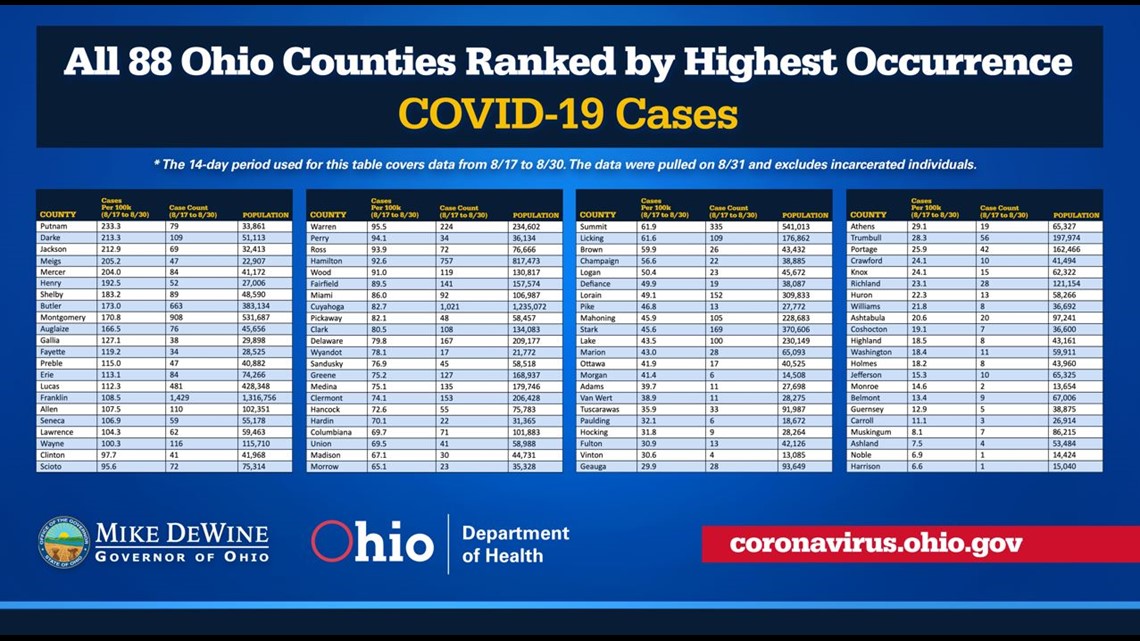
LABOR DAY WEEKEND
DeWine said that President Donald Trump and Vice President Mike Pence have expressed concern about the upcoming Labor Day weekend.
DeWine made note of spikes in cases following previous holiday gatherings.
In the weeks after the Fourth of July, the state averaged close to 1,500 cases per day – state leaders believe this was in large part because of holiday gatherings.
DeWine provided the below example of coronavirus spread from that weekend.

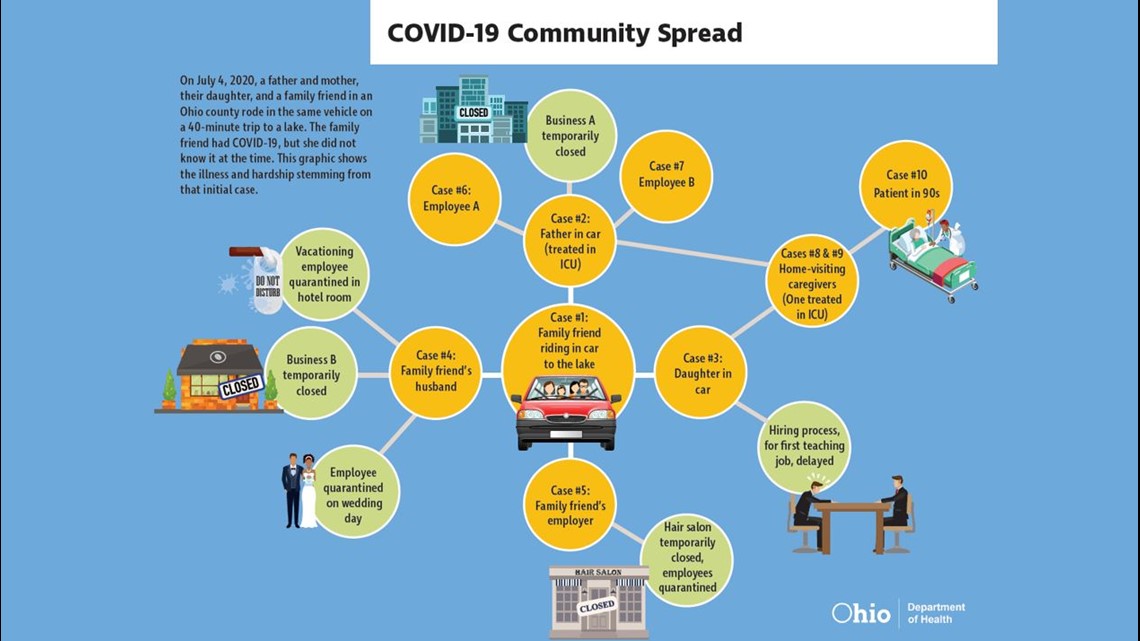
He encouraged Ohioans to continue doing their part to prevent the spread of COVID-19.
With many other weekend holidays still on the horizon, DeWine was asked if he had thought about issuing any orders regarding holidays t
SCHOOLS
Last week, DeWine announced he would be issuing an order requiring schools to create a reporting system for COVID-19 positive cases. DeWine said Tuesday his team is still working on the language of the order. Ohioans can expect the order to be officially issued sometime this week.
The governor said that when it is complete, the full order will be posted online here.
As a reminder, here are the goals of the order:
- Parents are notified if their kids have been in contact with someone COVID-19 positive.
- Parents are notified if someone in their child's building is COVID-19 positive.
- The public is aware of cases in their local districts.
BGSU STUDENT BREAKS DOWN EXPERIENCE ON CAMPUS
Xavi Boes, a Carey High School graduate and current student at Bowling Green State University made an appearance at Tuesday's conference. Boes explained what his experience on campus has been like so far this semester.
"There's a lot less students on our campus, which is the biggest change in my experience," he said.
Boes said that he thinks the changes have been to the benefit of students, allowing them to have in-person instruction and as close to a traditional college experience as possible considering the circumstances.
"We have 13 weeks left and we are all in this together as BGSU and I hope we can continue to do that moving forward," he said.
Boes said he thinks the attitude among most students has been relatively positive.
He explained that while there have been changes in regard to student activities and involvement, they are working to keep these institutions running while remaining in compliance with COVID-19 safety measures.
Boes said the university has implemented a "Falcon Commitment" which allows students who feel unsafe returning to campus to complete their education completely online. The commitment also asks that students who do choose to return to campus to take ownership of their decisions and make choices that keep the university and community safe.
BROADBAND CONNECTIVITY GRANT
Lt. Gov. Jon Husted announced the next steps in the state's plan to expand broadband. The K-12 Broadband Connectivity Grant was announced in July to allocate CARES Act funding towards helping students gain internet access.
There was a total of $83 million requested from the $50 million available.
For schools with smaller requests (under $20,000), the entire requested amount will be awarded, Husted said, for those who qualified.
For schools with requests above $20,000, the first $20,000 will be fully awarded and the remaining request will be awarded at 60% in order to ensure every qualifying school receives some support.
By the end of this week, schools will receive notifications of their final award and can begin the process of purchasing these items through the Ohio Dept. of Education and Broadband Ohio.
Districts interested in developing telehealth services can now review the Telehealth in Schools Blueprint, which provides a better understanding of lessons learned through the pilot project. The Blueprint can be found here.
Progress has also been made through Ohio’s Common Sense Initiative (CSI) to streamline broadband regulations through their new Artificial Intelligence (AI) tool, Husted said.

